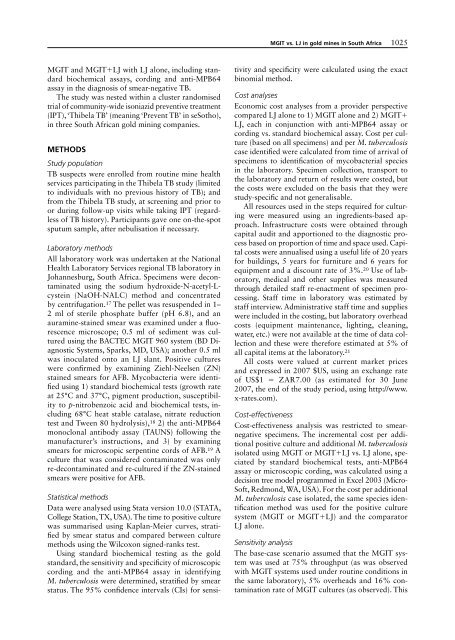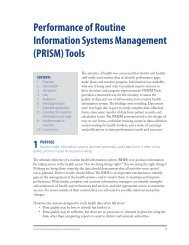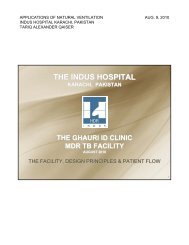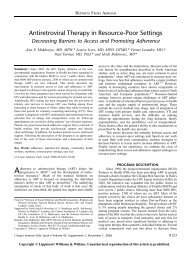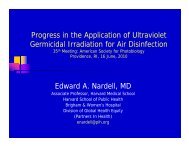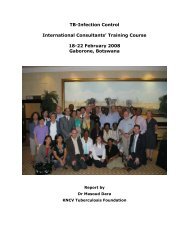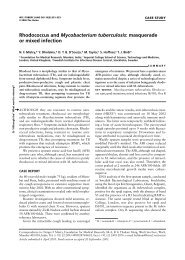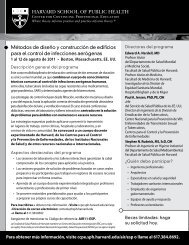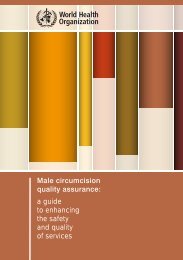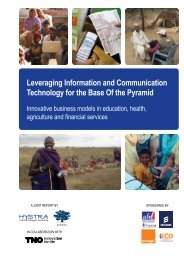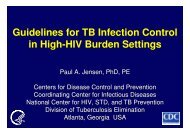Liquid vs. solid culture for tuberculosis: performance ... - GHDonline
Liquid vs. solid culture for tuberculosis: performance ... - GHDonline
Liquid vs. solid culture for tuberculosis: performance ... - GHDonline
Create successful ePaper yourself
Turn your PDF publications into a flip-book with our unique Google optimized e-Paper software.
MGIT <strong>vs</strong>. L J in gold mines in South Africa 1025<br />
MGIT and MGIT+LJ with LJ alone, including standard<br />
biochemical assays, cording and anti-MPB64<br />
assay in the diagnosis of smear-negative TB.<br />
The study was nested within a cluster randomised<br />
trial of community-wide isoniazid preventive treatment<br />
(IPT), ‘Thibela TB’ (meaning ‘Prevent TB’ in seSotho),<br />
in three South African gold mining companies.<br />
METHODS<br />
Study population<br />
TB suspects were enrolled from routine mine health<br />
services participating in the Thibela TB study (limited<br />
to individuals with no previous history of TB); and<br />
from the Thibela TB study, at screening and prior to<br />
or during follow-up visits while taking IPT (regardless<br />
of TB history). Participants gave one on-the-spot<br />
sputum sample, after nebulisation if necessary.<br />
Laboratory methods<br />
All laboratory work was undertaken at the National<br />
Health Laboratory Services regional TB laboratory in<br />
Johannesburg, South Africa. Specimens were decontaminated<br />
using the sodium hydroxide-N-acetyl-Lcystein<br />
(NaOH-NALC) method and concentrated<br />
by centrifugation. 17 The pellet was resuspended in 1–<br />
2 ml of sterile phosphate buffer (pH 6.8), and an<br />
a uramine-stained smear was examined under a fluorescence<br />
microscope; 0.5 ml of sediment was <strong>culture</strong>d<br />
using the BACTEC MGIT 960 system (BD Diagnostic<br />
Systems, Sparks, MD, USA); another 0.5 ml<br />
was inoculated onto an LJ slant. Positive <strong>culture</strong>s<br />
were confirmed by examining Ziehl-Neelsen (ZN)<br />
stained smears <strong>for</strong> AFB. Mycobacteria were identified<br />
using 1) standard biochemical tests (growth rate<br />
at 25°C and 37°C, pigment production, susceptibility<br />
to p-nitrobenzoic acid and biochemical tests, including<br />
68°C heat stable catalase, nitrate reduction<br />
test and Tween 80 hydrolysis), 18 2) the anti-MPB64<br />
mono clonal antibody assay (TAUNS) following the<br />
manufacturer’s instructions, and 3) by examining<br />
smears <strong>for</strong> microscopic serpentine cords of AFB. 19 A<br />
<strong>culture</strong> that was considered contaminated was only<br />
re-decontaminated and re-<strong>culture</strong>d if the ZN-stained<br />
smears were positive <strong>for</strong> AFB.<br />
Statistical methods<br />
Data were analysed using Stata version 10.0 (STATA,<br />
College Station, TX, USA). The time to positive <strong>culture</strong><br />
was summarised using Kaplan-Meier curves, stratified<br />
by smear status and compared between <strong>culture</strong><br />
methods using the Wilcoxon signed-ranks test.<br />
Using standard biochemical testing as the gold<br />
standard, the sensitivity and specificity of microscopic<br />
cording and the anti-MPB64 assay in identifying<br />
M. <strong>tuberculosis</strong> were determined, stratified by smear<br />
status. The 95% confidence intervals (CIs) <strong>for</strong> sensitivity<br />
and specificity were calculated using the exact<br />
binomial method.<br />
Cost analyses<br />
Economic cost analyses from a provider perspective<br />
compared LJ alone to 1) MGIT alone and 2) MGIT+<br />
LJ, each in conjunction with anti-MPB64 assay or<br />
cording <strong>vs</strong>. standard biochemical assay. Cost per <strong>culture</strong><br />
(based on all specimens) and per M. <strong>tuberculosis</strong><br />
case identified were calculated from time of arrival of<br />
specimens to identification of mycobacterial species<br />
in the laboratory. Specimen collection, transport to<br />
the laboratory and return of results were costed, but<br />
the costs were excluded on the basis that they were<br />
study-specific and not generalisable.<br />
All resources used in the steps required <strong>for</strong> culturing<br />
were measured using an ingredients-based approach.<br />
Infrastructure costs were obtained through<br />
capital audit and apportioned to the diagnostic process<br />
based on proportion of time and space used. Capital<br />
costs were annualised using a useful life of 20 years<br />
<strong>for</strong> buildings, 5 years <strong>for</strong> furniture and 6 years <strong>for</strong><br />
equipment and a discount rate of 3%. 20 Use of laboratory,<br />
medical and other supplies was measured<br />
through detailed staff re-enactment of specimen processing.<br />
Staff time in laboratory was estimated by<br />
staff interview. Administrative staff time and supplies<br />
were included in the costing, but laboratory overhead<br />
costs (equipment maintenance, lighting, cleaning,<br />
water, etc.) were not available at the time of data collection<br />
and these were there<strong>for</strong>e estimated at 5% of<br />
all capital items at the laboratory. 21<br />
All costs were valued at current market prices<br />
and expressed in 2007 $US, using an exchange rate<br />
of US$1 = ZAR7.00 (as estimated <strong>for</strong> 30 June<br />
2007, the end of the study period, using http://www.<br />
x-rates.com).<br />
Cost-effectiveness<br />
Cost-effectiveness analysis was restricted to smearnegative<br />
specimens. The incremental cost per additional<br />
positive <strong>culture</strong> and additional M. <strong>tuberculosis</strong><br />
isolated using MGIT or MGIT+LJ <strong>vs</strong>. LJ alone, speciated<br />
by standard biochemical tests, anti-MPB64<br />
assay or microscopic cording, was calculated using a<br />
decision tree model programmed in Excel 2003 (Micro-<br />
Soft, Redmond, WA, USA). For the cost per additional<br />
M. <strong>tuberculosis</strong> case isolated, the same species identification<br />
method was used <strong>for</strong> the positive <strong>culture</strong><br />
system (MGIT or MGIT+LJ) and the comparator<br />
LJ alone.<br />
Sensitivity analysis<br />
The base-case scenario assumed that the MGIT system<br />
was used at 75% throughput (as was observed<br />
with MGIT systems used under routine conditions in<br />
the same laboratory), 5% overheads and 16% contamination<br />
rate of MGIT <strong>culture</strong>s (as observed). This


